
12 minute read
Alice Cooper: Ol' Black Eyes is Back
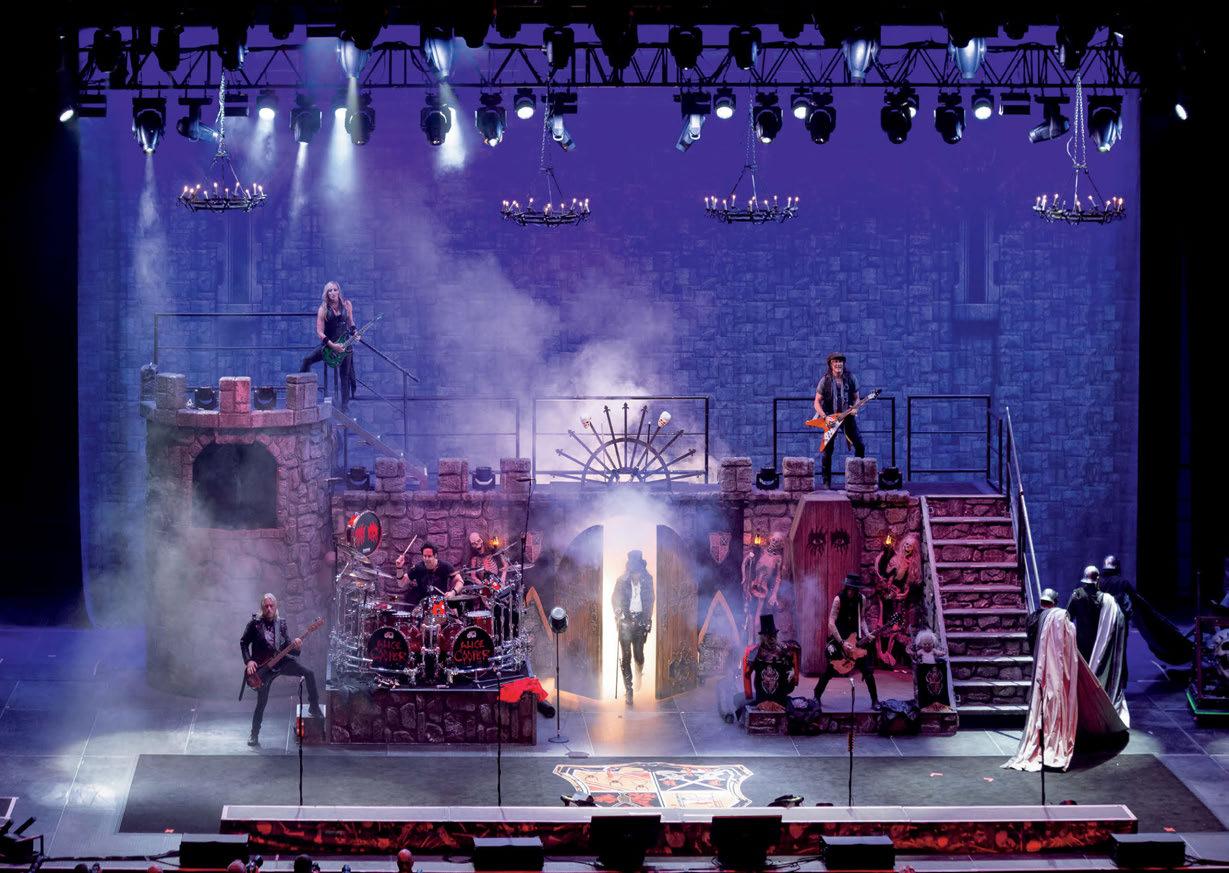
It would be amusing to have a conversation with the various focus groups and organisations who, in the ’60s and ’70s, made Alice Cooper the poster boy for controversy, and let them know that in 2019, he would still be playing in large arenas and reinventing his live horror shows to thousands of fans each night. The longevity of Cooper’s career is truly outstanding, and while watching his latest tour, Ol’ Black Eyes Is Back, it was clear to see that the 71-year-old still carries the charisma from back in the day – much to the delight of the fans, who rolled up to Manchester Arena, sporting Cooper shirts from decades past. With a stage centred around a large castle set piece, the entire show featured all the gags one would expect from the horror singer – and, yes, the guillotine was rolled out once again. Be fore the singer donned his top hat and hit the stage, TPi met up with the hardworking Cooper crew, who kept the wheels turning. Our first stop was with Production Manager, Cesare Sabatini. Having worked with Cooper since 2003, he has overseen several renditions of the singer’s show. “One of the first things I learned with the Alice tour is that you end up wearing a lot of hats,” began the PM, while sitting in catering having successfully brought the tour over from mainland Europe to the UK. “Every day I’m helping out with some stuff on stage, with all the theatrical elements alongside all the PM responsibilities. But that works for me. I’m certainly not just sitting in the office!” For the UK run, Sabatini brought out a selection of return suppliers, including SSE Audio, Christie Lites, Gallagher Staging, Snakatak, Stagetruck, Phoenix Bussing and Rock-It Cargo. “We’ve used SSE and Christie for all our recent tours in Europe,” stated Sabatini. “We’ve been able to have some of the same crew come out with us, such as Mark [Pantlin], our audio system engineer, which is great.” The PM explained that this familiarity in both suppliers and crew fed into the “family ethos”, integral to the Alice Cooper camp. “We like to keep the nucleus of the tour fairly similar,” he stated. “This goes from the top down, with some of the drivers from Stagetruck and Phoenix Bussing being
repeats from our last run.” But despite the faces backstage being familiar from the last run, the PM explained that this latest tour was a brand new concept. “The castle and all the elements alongside it are brand new,” laid out the PM. “I got involved in April to see the direction the tour was taking and spoke to Shep Gordon – Alice’s long-time manager – to hear what he and Alice were looking to create. I flew to Nashville to see Gallagher Staging and saw what had been created.” The PM then added his “two cents” to ensure that this elaborate castle structure could keep pace with the variety of venues Cooper was due to go through in the upcoming tour.
SET Another crewmember who embodied the ‘dual-hat’ nature of the tour, carrying the titles of Head Rigger, Stage Manager, Set Carp and CAD Designer, Kurt Grossen explained the daily demands of the stage build. “Being involved in several departments is actually a benefit in this camp,” stated Grossen, tearing himself away from his laptop and a selection of CAD files, as he planned how to fit the set pieces into the tour’s next few venues. “Cesare and I work on the advanced rigging plots. I do my laser measurements to make sure everything’s going to fit in as planned, then I start chalking the floor and getting all the rigging set up.” From that point onwards, Grossen explained how he flits between stage managing and rigging, orchestrating the various local hands in the various departments. “In terms of local crew, I usually deal with 22 on the load-in and 26 on the load-out,” he stated.
AUDIO Tasked with the responsibility of dealing with Cooper’s live mix was audio veteran Greg Price. The co-creator of Diablo Digital and FOH Mixer for the likes of Ozzy Osbourne, Price was one the newest faces to the Alice Cooper camp for the 2019 run. “I took over this tour from another engineer,” explained Price, who was excited at the challenge. “My goal, no matter what


PA Tech, Oliver Fallon, System Engineer, Mark Pantlin, Monitor Engineer, Eric Brown, FOH Engineer, Greg Price and Stage Tech, Conor Mullan; Monitor Engineer, Eric Brown; Lighting Director, Scott Warner.


artist I’m working with, is to represent their music and make it better than they ever dreamed it could have sounded. A lot of these bands and artists have written certified rock anthems and, each time I step to the desk, I want these tracks to sound better than ever.” Working alongside Price for the tour was Monitor Engineer, Eric Brown, PA Tech, Oliver Fallon, Stage Tech, Conor Mullan and System Engineer Mark Pantlin, with SSE Audio providing PA and control. “I’ve known all the folks at SSE for a number of years,” stated Price. “They are always wonderful to work with and it was great to have them on this tour.” As an extension of this, the FOH Engineer was quick to praise the work of his righthand man – System Engineer, Pantlin – who was integral in his goal to achieve the best audio possible. He elaborated: “The system and FOH engineer should function as a two-headed monster. The days of one person sitting behind a mixing desk are over, especially in the modern era where we are talking about things such as immersive audio.” Brining Pantlin into the conversation, he talked TPi through his daily ritual of measuring the room. “Virtually everything I do runs via the SoundVision software,” he began. “Everything from system design, to coverage, and even some air compensation is done within the system.” Th e system in question was an L-Acoustics K1 package – a speaker Price dubbed as the “gold standard”. For the Manchester show, the system consisted of 10 K1s and five K2s per side, with 24 KS28s, six Karas for lip fills and four for out fills. “On my side at the front end we have a Lake Processing LM 44, which then goes into an L-Acoustics P1 Processor, which is then transferred via AVB to the stage,” stated Pantlin. Meanwhile for control, Price utilised the Yamaha RIVAGE PM7. As an early adopter of the Yamaha PM5D back in the day, Price explained that he hadn’t used the brand for some years but had been really impressed with the result. “First of all, I think that the mic preamps are stunning,” he started.
“But what really makes this console interesting is the onboard Rupert Neve facility, especially compared to other brands on the market. You don’t have to plug in another system or download a special package – this all comes factory standard. The fact you can stay within the architecture of the console is ideal, as it cuts down on latency and other issues that can occur when you have to bring extra cables and jacks into the equation.” Th e engineer went on to explain some of the interesting challenges of mixing a band in the modern age. Although known by many in the industry for producing his own recording system for the live environment – which was also present on his FOH package – Price explained that, these days, you also have to mix with the knowledge that people will often see and hear the show back on footage captured on a mobile phone. “It’s the new format in which engineers’ mixes are judged,” he commented. “It’s the medium of the day and you have to be aware of it.” Although making a mix with his own Diablo Digital system, he commented that the band often used YouTube as a reference to listen back to the show each night. “If you’re aware that it will be recorded by a number of people and you ensure that your mix is balanced correctly, it will sound good on a phone recording. Someone recorded the whole show in Paris and uploaded it to YouTube – I’m pretty happy with the result.”
MONITORS Moving to the side of stage, TPi met Monitor Engineer, Eric Brown, who stood behind an Avid Profile, aptly decorated with several pieces of horror memorabilia and even one head of Alice Cooper – guess the boss is always watching. For this run, the Alice Cooper stage setup had changed, with the band switching to Kempers rather than a traditional cabinet setup. “In my short time with the band, it feels as though everyone has embraced them,” chipped in Price. “It’s a bit of a no-brainer, with all the band on IEMs.” It’s a

Production Manager, Cesare Sabatini; Head Rigger and Stage Manager, Kurt Grossen.
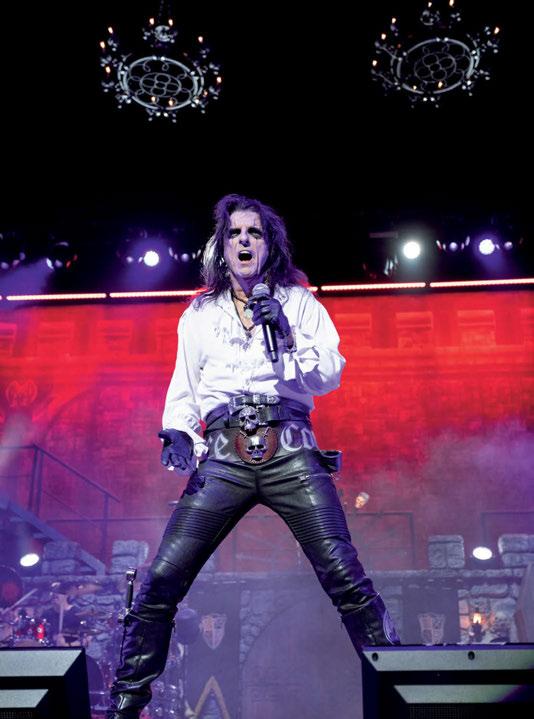

sentiment that was shared by Brown. “It has created a whole new level of consistency,” he stated. “I worked with the band on the previous tour when we had a traditional cabinet setup for the guitars. We did a week of preproduction when the band got everything dialled in. The tone we have got has just been so consistent, no matter what room we are playing in.” As a S hure-endorsed act, a number of products from the company’s microphone and IEM line were featured throughout the stage. For IEMs, the band used Shure PSM 900s with P10R bodypacks. “T he best thing about the P10Rs has been the dual diversity,” stated the engineer. “It gives that bit more coverage, which is great, as the band tend to move around the stage quite a lot. But even when they stand on the subs, the coverage has still been great.” For IEM moulds, the majority of the
band and crew were on Jerry Harvey – either Roxannes or JH7s. The only exception was guitarist Nita Straus, who is a “die-hard” Ultimate Ears user. Al ong with all the IEM mixes, Brown also had a separate side fill mix. “Even though everyone is on in-ears, we kept the side fills as a bit of a safe guard,” commented the engineer. “If there are any RF issues, they can take out their in-ears and still have a workable mix on stage. “A lice never really asks for a full production mix, but he wants to hear a little bit of everything,” continued Brown, while discussing the requests from the main man. “I do everything live for my mix – there are a lot of elements where I’m reacting to certain things on stage.” One of the main things Brown had to keep an eye on was the band’s tendency to switch microphone positions. “Thankfully it’s all loosely choreographed now,”
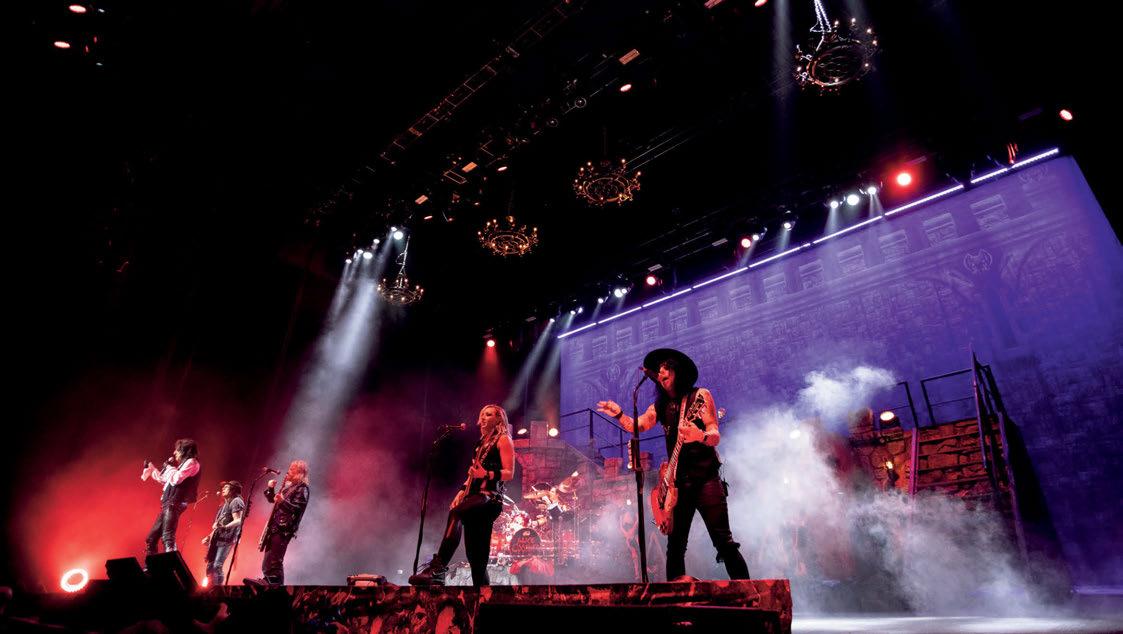
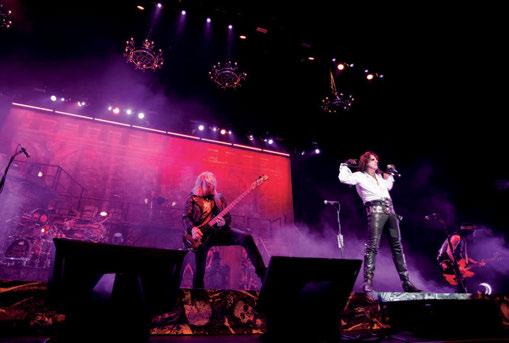
chuckled Brown, as he reminisced about a time in rehearsals when the band played School’s Out, and it was a free-for-all on mic positions. “Needless to say, it wasn’t the simplest task.” Br own spoke of his decision to work with the Avid Profile. “I considered moving onto a Yamaha along with Greg. However, at this time I decided to stick with the Profile for ease and comfort. There might be some changes down the line but, for right now, it’s working really well.” To close, the Monitor Engineer commented on the collaboration with audio supplier SSE Audio. “This is my first time working with them and it has been great,” he commented. “Conor and Olly, our tech, have been absolutely fantastic. It’s been a very pleasant experience. It’s also great to get one of their custom rack plates!”
LI GHTING Manning the visual look of the shows was Lighting Director, Scott Warner. With one of the most varied lighting CVs imaginable, the LD has worked with the likes of The Pussycat Dolls and Queen Latifa as well as rock bands including Stone Sour and Gwar. “I’ve always tried to stay away from being labelled as one thing,” laughed Warner, after listing his eclectic client list. “If you market yourself as a ‘rock LD’, you end up doing the same thing again and again.” However, if his Alice Cooper hoodie wasn’t giveaway, this particular tour was something of a bucket-list job for Warner. “I was brought in originally by their previous LD, Joel Reiff, who’s an old friend of mine. I’ve been a fan of Alice Cooper since I was 12 years old, so being given the chance to light tracks such as Billion Dollar Baby made it an easy decision.” Having taken on the job, Warner was brought into the creative department, which already had Show Designer, Chris Lisle, in place. “When
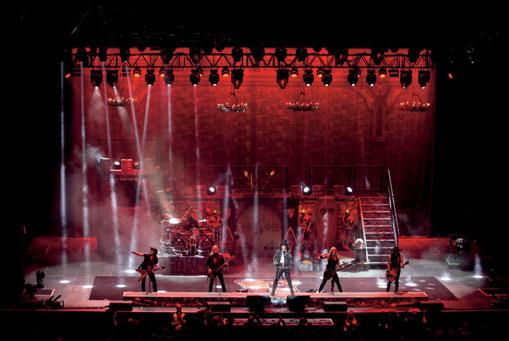
I picked up the show in America, the set and most of the fixtures were already in place. I then began programming a lot of the show.” Al l of Warner’s looks were given the final green light by Alice Cooper’s manager, Shep Gordon. “I’d been a fan for such a long time and was already familiar with Shep’s name,” stated the LD. “I remember as a kid seeing his name on the album sleeves and figuring ‘this guy is a big deal’. I did a lot of research before I started designing this show and I knew that he likes big Parcan looks with limited movement. I kept that in mind with the design, which he seemed to enjoy. We’ve got the show fairly locked in at this stage.” Although the look of the show has remained constant between the US and European runs, some of the fixtures were swapped when Christie Lites was brought into the picture. Some of the main changes have been on the backdrop, where Warner deployed a selection of Chroma-Q Color Forces to illuminate the rear of the stage. Another alteration was the GLP JDC – a fixture Warner is particularly fond of. Also on the rig were collection of Martin by Harman MAC Vipers. “We have a selection of them on our front truss, which take care of our gobo looks,” Warner noted. “The optics on the Vipers are really good and the hope is to keep them for the American tour.” A collection of Martin By Harman MAC Auras were also utilised. The final addition to the LD’s fixture list was the Robe Cyclones – a fixture Warner had a hand in developing. “They’re a fantastic little unit,” professed Warner, clearly happy to have the Cyclone on his rider package. The fixture, which incorporates an LED ring along with a fan in the centre, is designed to give the LD a greater level of control of some of the effects taking place on stage. Warner explained: “On this set, for example, we have a dry ice simulator on the side of stage. But sometimes, due to the humidity of the room, all
the fog bunches in the middle of the stage, obscuring the audience’s view. If that happens, I turn on the fan in the Cyclones to reveal Alice.” The LD also spoke of the confetti hit that took place during the show, where the Cyclones fan was able to keep any confetti off the stage and out of the band’s way. For control, the LD opted for an MA Lighting grandMA2. “It’s been my go-to for years,” commented Warner, reminiscing about the first time he used the desk. “One of the things that drew me to it in the first places was that it was black,” he laughed. He then referenced some of his work with various pop groups as the reason for learning more skills on the desk. “The macro setup I’ve got for this tour is ridiculous. I fire one button and it sets everything off, from lights to bubbles.” Supplying the tour with all its lighting requirements was Christie Lites. Working alongside Warner from Christie were Ryan Harrington, Henry Gillett and Crew Chief, Aidan McCabe. “I really like Christie and have no complaints for this entire run,” enthused the LD. “I have to give special thanks to our Crew Chief, Aidan, who has been fantastic.” Wi th the lifelong fans of Alice from up and down the UK getting their fix of Ol’ Black Eyes, the band and crew made their way back Stateside to take up another leg of the tour, which will see them all the way to the end of the November, before heading Down Under for an Australian run in early 2020. TPi Photos: Andrew Benge www.alicecooper.com www.sseaudiogroup www.christielites.com www.gallagherstaging.com www.snakatakcatering.com www.stagetruck.com www.phoenix-bussing.co.uk www.rockitcargo.com
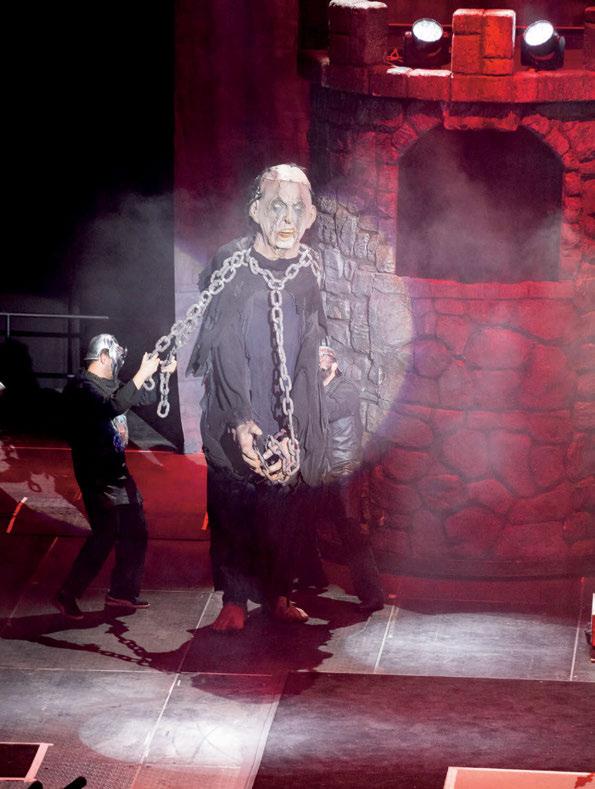
IP65 RATED


